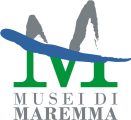Museo Archeologico Polveriera Guzman di Orbetello
Address
Via Mura di Levante, n. 3 – Orbetello
Museum
The Archaeological Museum of Orbetello is located on the first floor of the Guzman powder magazine, a building built in 1692 by the Flemish architect Ferdinand De Grunembergh. The building, which in a first phase had the generic function of warehouse, later became a gunpowder depot and took its name from the nearby bastion, dedicated to the Viceroy of Spain Enrique de Guzmàn. In the exhibition there are archaeological finds from various periods, from prehistoric times to the Etruscan-Roman period, recovered in the area from the early nineteenth century to the purchases made in the second half of the twentieth century. The materials concern three main groups: those from the Etruscan necropolis of the Isthmus of Orbetello with objects of the Orientalizing-Archaic and Classical-Hellenistic age, those from the Talamone area and a large group of purchases from the areas of Pescia Romana, Chiarone, San Donato and Monte Argentario. Among the important artefacts are the materials from the Orbetello necropolis that belonged to the rich Etruscan aristocracy of the 4th century BC: gold ornaments decorated with embossed technique, bronze materials and ceramics linked to the banquet, bronze mirrors with unique subjects such as “Cathesan”, a character identified on one of them by an engraved Etruscan inscription. From Talamone, and precisely from the Talamonaccio hill, in addition to the decorative elements of the doors of the Hellenistic temple, you can see bronze objects found towards the end of the nineteenth century and coming from two closets or votive cabinets containing spear points, knives, miniature objects depicting offensive and defensive weapons, miniature agricultural tools and two helmets, one of which with an Etruscan inscription. Both closets seem to be probably linked to an agricultural-warrior cult or in any case the demonstration of the existence in the classical or Hellenistic age of an aristocratic class linked to the land and to war.
Activities
Guided tours, educational activities by reservation for groups and / or school groups
Bookshop
Yes
Accessibility disabled
Not accessible
Schedule
From January 1st to March 31st
Saturday 2.30pm – 5.30pm
Sundays and holidays 10 am-1pm
From April 1st to June 30th
Saturday 16 – 19
Sundays and holidays 10 am – 1 pm and 4 pm – 7 pm
From 1st July to 31st August
Saturday, Sunday and holidays 6pm – 11pm
From 1st September to 30th September
Saturday 16 – 20 Sundays and holidays 9 – 13 and 16 – 20
From 1st October to 31st December
Saturday 2.30pm – 5.30pm
Sundays and holidays 10 am – 1 pm
Closing days: 1st January, 1st May, from 23rd to 26th December (inclusive)
Price
free entry
Contacts
Info and reservations: 3505905073 (Museo) 0564861111 (Comune)
Email: museoguzman@comune.orbetello.gr.it
Web: https://www.comune.orbetello.gr.it/news/dettaglio.asp?id_articolo=7531

